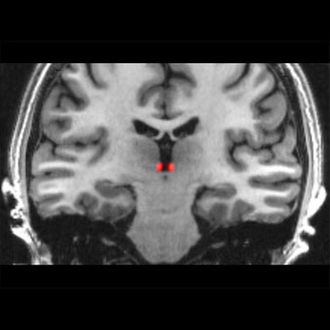
It’s a teensy-tiny part of your brain — smaller than a pea, to be precise — and yet it’s tasked with some pretty big responsibilities: The habenula stays on the lookout for the bad stuff in our environment, helping us to avoid potentially painful or dangerous situations.
Previously, the habenula’s role had only been demonstrated in animals, but a study recently published in the Proceedings of the National Academy of Sciences is the first to show that it plays the same role in the human brain, according to lead study author Rebecca Lawson, a University College London neuroscientist. Science of Us emailed Lawson to understand more about the tiny worrywart living inside our brains.
What exactly is the habenula?
As Lawson described it, “the habenula is a small and evolutionarily well-preserved nucleus in the brain.” And when she says small, she means small. The habenula is three millimeters by three millimeters by three millimeters — “smaller than a pea or a corn kernel,” she said.
Where is it in the brain, and what does it do?
“Unlike the wrinkly cortex that we usually picture when we think about the brain, the habenula is buried deep in the middle of the brain,” Lawson said. All vertebrates — animals with backbones — have one, from fish all the way up to humans, she explained. Previous studies in animals have shown that the habenula keeps track of negative experiences, and starts firing away to warn when something painful or dangerous is expected.
How does this new study add to the existing research in this area?
Lawson and her colleagues examined the brain scans of 23 adults, who were shown a series of images while in a functional magnetic resonance image scanner. Some images were accompanied with painful electric shocks, and others were associated with winning money. When the participants saw the images associated with the shocks, the habenula’s activity picked up; when the images linked to the money were shown, however, the habenula stayed quiet. This suggests, Lawson explained, that the tiny structure functions in humans similar to the way it functions in animals, firing its cells as a way of predicting negative events.
What will the focus be for the next wave of habenula research?
Scientists are beginning to investigate the role this little piece of the brain plays in depression. “We are currently working with the hypothesis that the habenula might be overactive in people with depression, and this might contribute to some of their depressive symptoms,” Lawson explained. In depressed people, a hyperactive habenula could be triggering the low expectations and overly negative outlook associated with the mental illness.
Also, there’s some evidence suggesting that an active habenula may result in lower motivation; for example, people in this current study whose brain scans showed a hyped-up habenula were slower to respond when told to press a button. Whatever the future findings, big things may be ahead for this small piece of the human brain.




